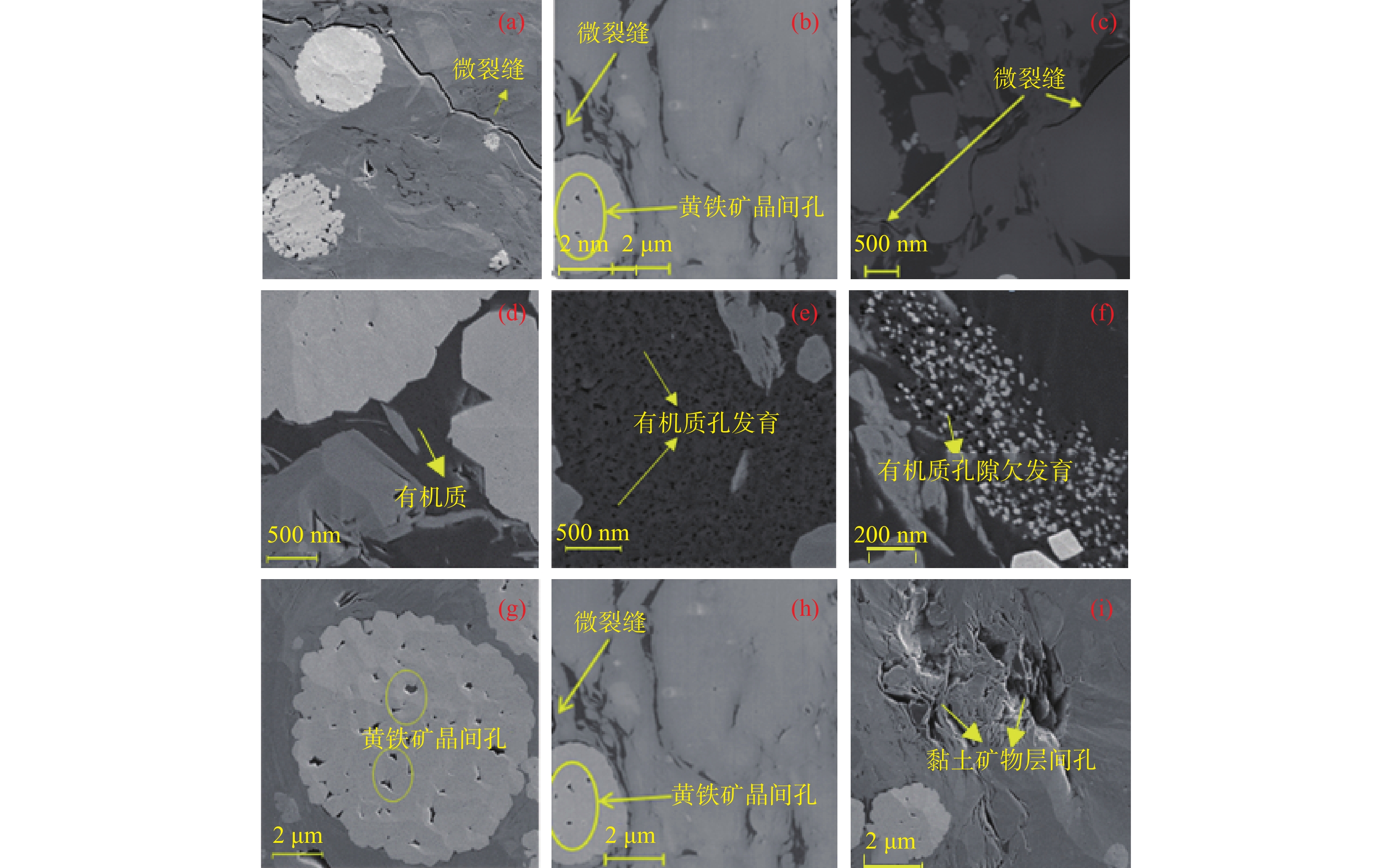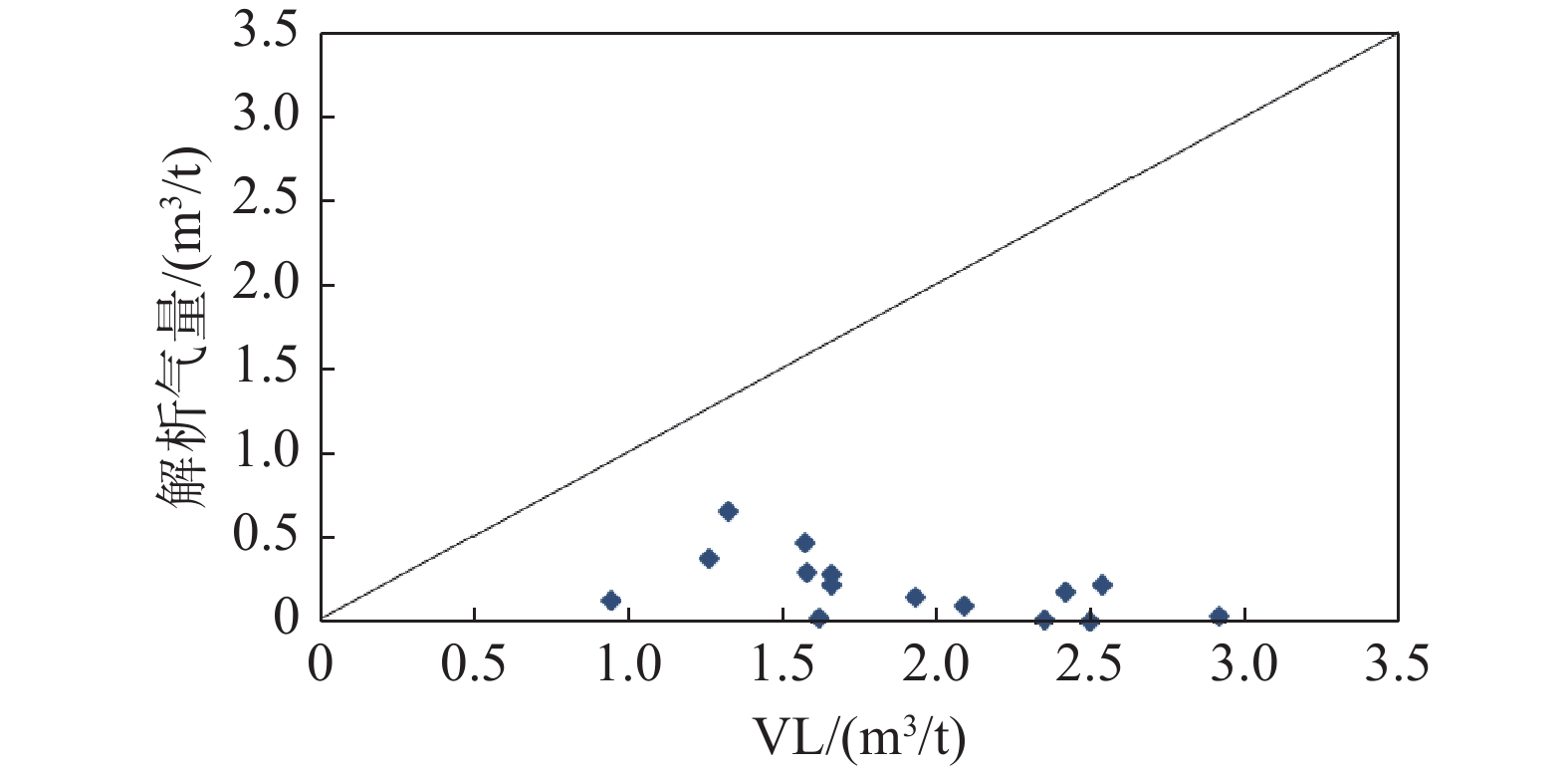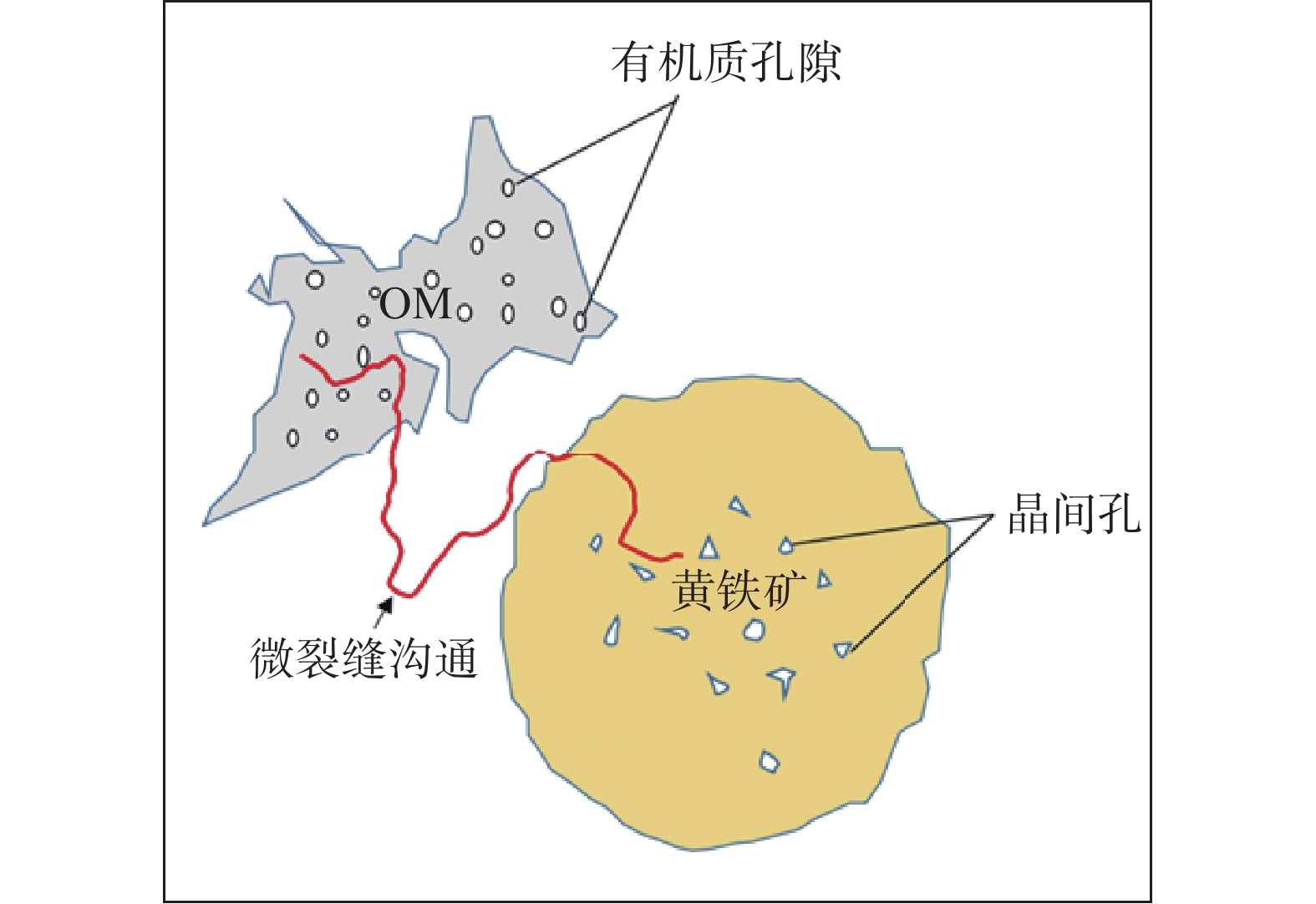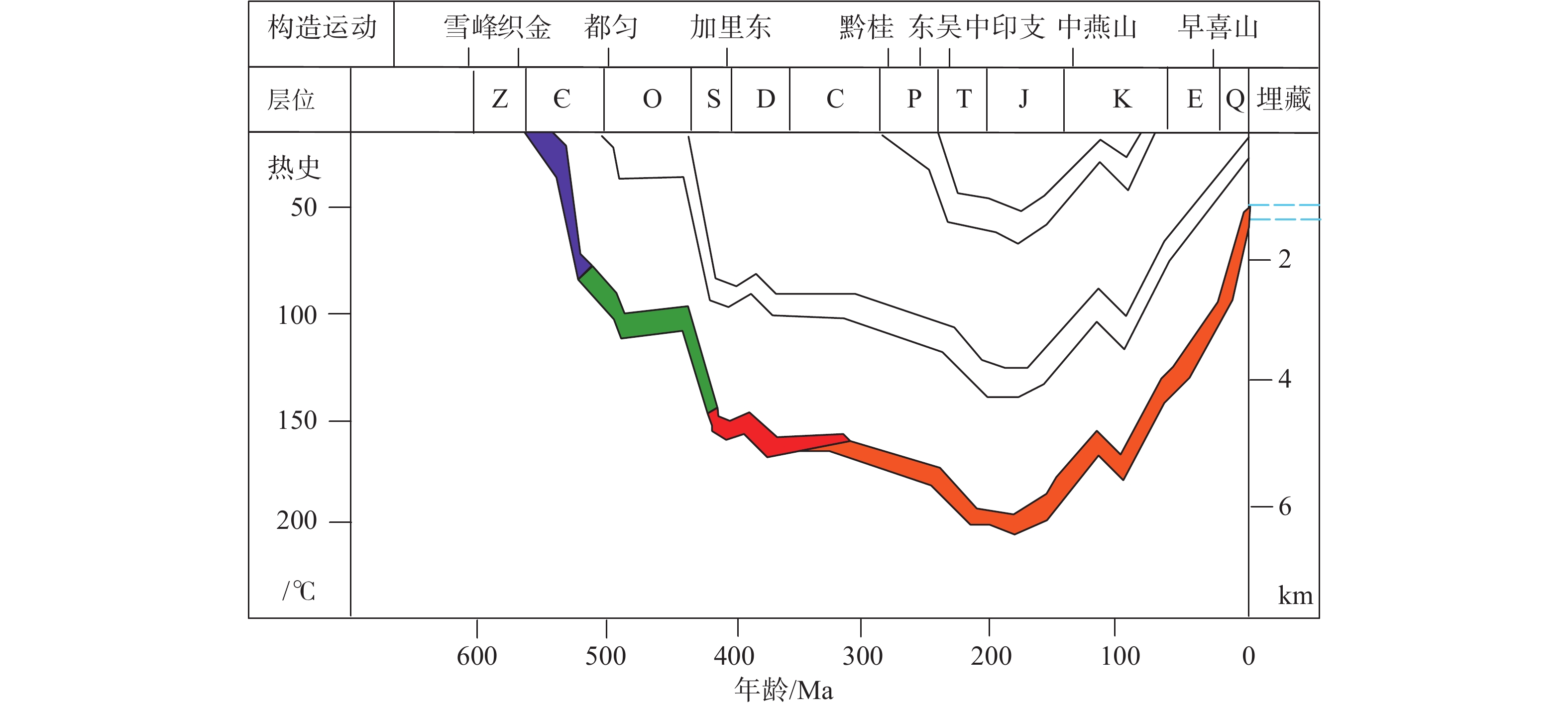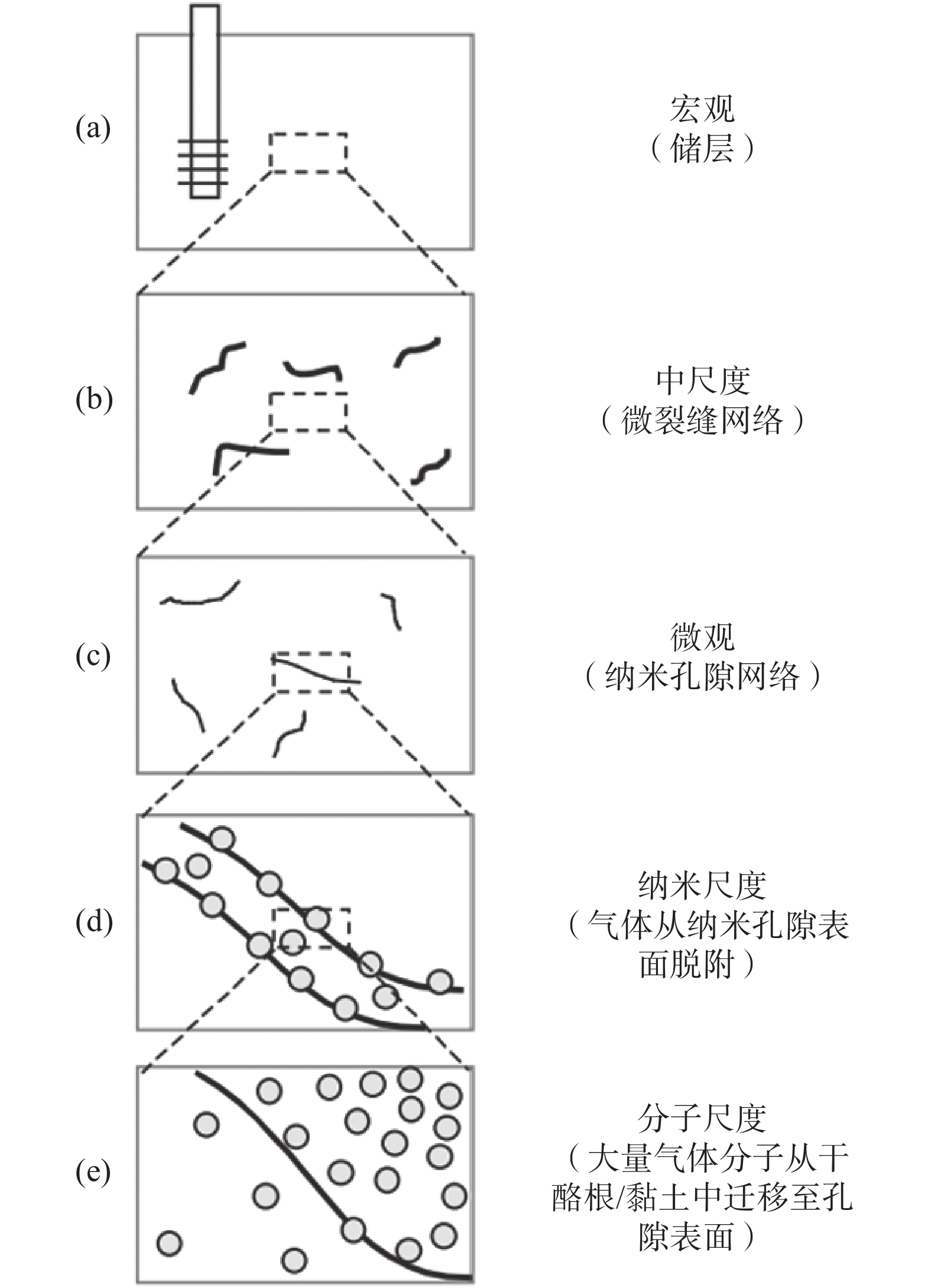Multi−scale characterization of shale pore structure of Niutitang Formation in southeastern Guizhou and its influence on shale gas enrichment
-
摘要:
研究目的 研究黔东南地区牛蹄塘组页岩孔隙结构特征及其对页岩气富集的影响,抛开不利因素,为黔东南地区页岩气勘探提供建议。
研究方法 通过聚焦离子束扫描电镜(FIB−SEM)、场发射扫描电镜(FE−SEM)和氮气吸附等手段,对页岩微纳米孔隙结构进行多尺度表征,并结合研究区牛蹄塘组页岩的生烃及埋藏史,研究构造运动与孔隙结构关系,进而分析对页岩气富集的影响。
研究结果 牛蹄塘组页岩主要发育毫米级微裂缝、微米级黄铁矿晶间孔以及纳米级有机质孔隙,以墨水瓶状孔隙和平板结构的狭缝孔为主,孔隙结构复杂;结合FIB−SEM三维重构结果,有机质在页岩中占比较高,其孔隙度在0.04%~2.48%,对总孔隙的贡献率介于14%~96%,与有机质共生的黄铁矿晶间孔是沟通裂缝的主要孔隙类型;该地区页岩气赋存状态以欠饱和的吸附气为主,游离气含量偏低。
结论 牛蹄塘组页岩大量构造裂缝,沟通了有机质孔及黄铁矿晶间孔,改变了原有孔隙结构,致使原位聚集的页岩气沿裂缝逸散,是牛蹄塘组页岩含气量低的关键因素。热演化程度适中、构造保存好的区域是古隆起周缘下一步页岩气勘探的有利方向。
Abstract:This paper is the result of oil and gas exploration engineering.
Objective It is necessary to study the pore structure characteristics of Niutitang Formation shale in Southeast Guizhou and its influence on shale gas enrichment, avoid unfavorable factors, and provide suggestions for shale gas exploration in Southeast Guizhou.
Methods Multi−scale characterization of the shale micro−nano pore structure is carried out by means of focused ion beam scanning electron microscopy (FIB−SEM), FE−SEM, and nitrogen adsorption. Combined with the hydrocarbon generation and burial history of the Niutitang Formation shale in the study area, the relationship between tectonic movement and pore structure is studied, and its control effect on shale gas enrichment is analyzed.
Results The Niutitang Formation shale mainly develops millimeter−scale micro−cracks, micron−scale pyrite intercrystalline pores and nano−scale organic pores, mainly ink bottle−shaped pores and slit pores with a flat plate structure, and the pore structure is complex. Combined with the results of FIB−SEM three−dimensional reconstruction, organic matter accounts for a relatively high proportion of shale, with a porosity of 0.04%−2.48% and a contribution rate of 14%−96% to the total porosity. The pyrite crystals co−existing with organic matter Pores are the main type of pores that communicate fractures, the shale gas in this area is dominated by undersaturated adsorbed gas, and the free gas content is low.
Conclusions A large number of structural fractures in the Niutitang Formation shale have connected organic matter pores and pyrite intercrystalline pores, and changed the original pore structure, causing the in−situ accumulated shale gas to escape along the fractures, which is a key factor in the low gas content of the shale of the Niutitang Formation. Finding areas with moderate thermal evolution and well−preserved structures is a favorable direction for shale gas exploration on the periphery of paleo−uplifts.
-

-
图 12 不同尺度下页岩气流动及产出(据Javadpour, 2007)
Figure 12.
表 1 常见的微观孔隙检测方法
Table 1. Common microscopic pore detection methods
检测方法 特点 局限性 氩离子抛光-扫描
电镜/Ar−ion Milling SEM页岩二维孔隙结构的定性研究,能够快速观测页岩样品中的孔隙含量、分布及孔径范围 仅适用于二维微纳米孔隙刻画,无法反映三维空间结构 宽离子束-扫描电镜/ BIB−SEM 场发射扫描电镜/ FE−SEM 页岩二维孔隙结构的定性研究,进行样品表层的微区点线面元素的定性、半定量及定量分析 氦离子扫描电镜/HIM 是FE−SEM的补充,提供更强的样品表面信息对比度机制 小角X射线散射/ SAXS 几十纳米以下微孔隙 后期数据分析处理受限 (超)小角度中子散射/(U)SANS 纳米孔隙分布和几何形态 核磁共振 微纳米孔隙全孔径分析,定性划分有机、无机孔 孔径分布准确性受影响 高压压汞法 微纳米孔隙孔径分布、孔吼形态及发育情况,定性判断孔吼连通性 不适于表征微孔,且造成样品无法二次利用 微米X射线显微镜/ Micro−CT 表征页岩三维空间结构特征 仅适合于表征页岩亚微米级至微米级孔隙结构 纳米透射X射线显微镜/Nano−CT 反映三维空间结构,更加精确地实现页岩组分定量研究 分辨率有限,不适宜表征页岩介孔及微孔 聚焦离子束−扫描电镜/FIB−SEM 数纳米级分辨率下,对页岩孔隙进行三维重构,定性、定量分析纳米—微米级孔隙度、孔径及连通性 页岩纳米级孔隙三维结构研究的主要技术手段,视域小,需结合MAPS技术综合分析 表 2 样品基本信息
Table 2. Basic information of samples
序号 层段 岩性 TOC/% Ro/% 石英/% 碳酸盐/% 黄铁矿/% 伊利石相对含量/% HD−1 牛蹄塘组上段 含碳酸盐钙质页岩 2.5 1.44 28 35 3 37 HD−2 牛蹄塘组上段 含碳质页岩 1.39 2.12 35 4 4 32 HD−3 牛蹄塘组上段 含碳质页岩 0.84 2.65 34 0 4 34 HD−4 牛蹄塘组上段 含碳质页岩 2 / 29 9 4 27 HD−5 牛蹄塘组中段 含粉砂质碳质页岩 0.79 / 32 / 4 39 HD−6 牛蹄塘组中段 含粉砂质碳质页岩 5.85 2.71 28 4 11 43 HD−7 牛蹄塘组下段 碳质页岩 5.67 / 43 7 6 40 HD−8 牛蹄塘组下段 碳质页岩 2.97 / 43 4 6 45 HD−9 牛蹄塘组下段 含粉砂质碳质页岩 3 2.79 43 4 5 45 HD−10 牛蹄塘组下段 碳质页岩 6.01 / 53 5 4 48 表 3 黄地1井页岩样品三维重构结果
Table 3. 3D reconstruction results of shale samples in Huangdi Well 1
样品编号 深度/m 三维重构孔隙度/% 有机质孔隙度/% 贡献率/% 孔径分布区间/nm 有机质占比重/% 黄铁矿占比重/% HD−1 1285.40 0.42 / / 10~60 7.77 2.68 HD−2 1292.30 0.37 0.08 22.29 10~100 3.18 2.91 HD−3 1302.00 0.29 0.04 13.79 10~100 3.63 1.64 HD−6 1331.45 0.58 0.24 41.03 10~100 10.20 4.87 HD−9 1369.95 2.57 2.48 96.56 10~80 21.70 / 表 4 黄地1井低温N2吸附孔隙结构参数
Table 4. Pore structure parameters of low temperature N2 adsorption in Huangdi Well 1
样品编号 BET比表面积/
(m2/g)BJH 解吸总孔体积/
(mL/g)平均孔径/
nmHD−1 4.273 0.00123 3.3 HD−2 3.933 0.00118 3.13 HD−3 6.693 0.00411 3.86 HD−4 6.692 0.00788 5.64 HD−5 7.035 0.00335 3.45 HD−6 10.023 0.00438 3.2 HD−7 13.411 0.00101 2.37 HD−8 8.091 0.00398 3.31 HD−9 5.178 0.00103 3.05 HD−10 11.248 0.00319 2.68 -
[1] Bao Shujing, Zhai Gangyi, Zhou Zhi, Yu Shufang, Chen Ke, Wang Yufang, Wang Hao, Liu Yimin. 2018. The evolution of the Huangling uplift and its control on the accumulation and preservation of shale gas[J]. China Geology, 1: 346−353. doi: 10.31035/cg2018052
[2] Bowker K A. 2007. Barnett Shale gas production, FortWorth Basin: Issues and discussion[J]. AAPG Bulletin, 91(4): 523−533. doi: 10.1306/06190606018
[3] Chen D Z, Zhou X Q, Fu Y, Wang J G, Yan D T. 2015. New U−Pb zircon ages of the Ediacaran−Cambrian boundary strata in South China[J]. Terra Nova, 27: 62−68. doi: 10.1111/ter.12134
[4] Chen Fangwen, Lu Shuangfang, Ding Xue. 2015. Evaluation model of gas adsorption capacity of shale: A case of adsorbed gas content from Niutitang Formation in Qiannan depression[J]. Journal of China University of Mining & Technology, 44(3): 508−513 (in Chinese with English abstract).
[5] Chen Fangwen, Lu Shuangfang, Ding Xue. 2016. Gas generation period and quantity of organic−rich Niutitang shale in Qiannan Depression, China[J]. Journal of China University of Pretroleum, 40(3): 55−62 (in Chinese with English abstract).
[6] Curtis J B. 2002. Fractured shale gas systems[J]. AAPG Bulletin, 11: 1921−1938.
[7] Ge Mingna, Bao Shujing, He Wei, Chen Xianglin, Lin Tuo, Chen Ke. 2018. The discovery of shale gas in Lower Cambrian marine shale gas at Huangdi−1 well in Huangping region of northern Guizhou[J]. Geology in China, 45(4): 851−852 (in Chinese with English abstract).
[8] Ge Mingna, Chen Ke, Chen Xianglin, Wang Chao, Bao Shujing. 2020. The influence factors of gas−bearing and geological characteristics of Niutitang Formation shale in the southern margin of Xuefeng Mountain ancient uplift: A case of Well Huangdi 1[J]. China Geology, 3(4): 533−544. doi: 10.31035/cg2020072
[9] Ge Mingna, Ren Shoumai, Guo Tianxu, Wang Shengjian, Zhou Zhi. 2020. Identification method of marine shale gas 'High−Quality Layer' in the Lower Paleozoic area, Southern China and its application[J]. Rock and Mineral Analysis, 39(3): 350−361 (in Chinese with English abstract).
[10] Ge Mingna, Ren Shoumai, Guo Tianxu, Zhou Zhi, Wang Shengjian, Bao Shujing. 2018. Characterizing the micropores in lacustrine shales of the Late Cretaceous Qingshankou Formation of Southern Songliao Basin, NE China[J]. Acta Geologica Sinica(English Edition), 92(6): 2267−2279.
[11] Javadpour F, Fisher D, Unsworth M. 2007. Nanoscale gas flow in shale gas sediments[J]. Journal of Canadian Petroleum Technology, 46(10): 55−61.
[12] Jiao Shujing, Zhang Hui, Xue Dongchuan, Ma Yong. 2015. Study on morphological characteristics of micropores and microcracks in shale[J]. Journal of Chinese Electron Microscopy Society, 34(5): 421−427 (in Chinese with English abstract).
[13] Jin Chong, Chen Anqing, Lou Zhanghua, Li Sanzhong. 2012. Tectonic movement, fluid response and hydrocarbon preservation of Southern Guizhou depression[J]. Journal of Zhejiang University (Engineering Science), 46(10): 1910−1922 (in Chinese with English abstract).
[14] Jiu Kai, Ding Weilong, Wang Zhe, Huang Yong, Zhu Baocun, Zhang Zhenhua, Zeng Weite, Wang Ruyue. 2016. Reservoir space and evolution on process of Longmaxi shale in the Fenggang area of northern Guizhou[J]. Earth Science Frontiers, 23(1): 195−205 (in Chinese with English abstract).
[15] Li Z, Zhang J C, Gong D J, Tan J Q, Liu Y, Wang D S, Li P, Tong Z Z, Niu J L. 2020. Gas−bearing property of the Lower Cambrian Niutitang Formation shale and its influencing factors: A case study from the Cengong block, northern Guizhou Province, South China[J]. Marine and Petroleum Geology, 120: 104556. doi: 10.1016/j.marpetgeo.2020.104556
[16] Li Zhong, Zhao Shengxian, Feng Xiao, Liu Yongyang, Li Bo, Xia Ziqiang, Zhang Chenglin, Cao Lieyan. 2021. Application of large field splicing scanning electron microscopy on quantitatively evaluation of shale pore structure: A case study of Longmaxi Formation reservoir in deep western Chongqing Block to southern Sichuan[J]. Reservoir Evaluation and Development, 11(4): 569−576 (in Chinese with English abstract).
[17] Liang Xing, Zhang Tingshan, Shu Honglin, Min Huajun, Zhang Chao, Zhang Lei. 2020. Evaluation of shale gas resource potential of Longmaxi Formation in Zhaotong National Shale Gas Demonstration Area in the northern Yunnan−Guizhou[J]. Geology in China, 47(1): 72−87 (in Chinese with English abstract).
[18] Liang Xing, Zhang Tingshan, Yang Yang, Zhang Chao, Gong Qisen, Ye Xi, Zhang Jiehui. 2014. Microscopic pore structure and its controlling factors of overmature shale in the Lower Cambrian Qiongzhusi Fm, northern Yunnan and Guizhou Provinces of China[J]. Natural Gas Industry, 34(2): 18−26 (in Chinese with English abstract).
[19] Liu Ruiyin, Chen Qinggang, Wang Ganlu, Mou Yuliang, Zhou Hao, Shang Fuhua. 2016. Analysis of sealing property of Lower Cambrian Niutitang Shale in north area of Guizhou[J]. Coal Technology, 47(1): 72−87 (in Chinese with English abstract).
[20] Liu Z X, Yan D T, Niu X. 2020. Insights into pore structure and fractal characteristics of the Lower Cambrian Niutitang Formation Shale on the Yangtze Platform, South China[J]. Journal of Earth Science, 31(1): 169−180. doi: 10.1007/s12583-020-1259-0
[21] Ma Yong, Zhong Ningning, Cheng Lijun, Pan Zhejun, Li Hongying, Xie Qingming, Li Chao. 2015. Pore structure of two organic−rich shales in southeastern Chongqing area: Insight from focused ion beam scanning electron microscope (FIB−SEM)[J]. Petroleum Geology & Experiment, 37(1): 109−116 (in Chinese with English abstract).
[22] Ma Yong, Zhong Ningning, Huang Xiaoyan, Guo Zhouping, Yao Lipeng. 2014. The application of focused ion beam scanning electron microscope (FIB−SEM) to the nanometer−sized pores in shales[J]. Journal of Chinese Electron Microscopy Society, 33(3): 251−256 (in Chinese with English abstract).
[23] Ma Y, Zhong N N, Li D H, Pan Z J, Cheng L J, Liu K Y. 2015. Organic matter/clay mineral intergranular pores in the Lower Cambrian Lujiaping Shale in the north−eastern part of the upper Yangtze area, China: A possible microscopic mechanism for gas enrichment[J]. International Journal of Coal Geology, 137: 38−54. doi: 10.1016/j.coal.2014.11.001
[24] Men Yupeng, Yan Jianfei, Qi Minghui, Xiong Guoqing, Ma Long, Yang Fei, Kang Jianwei. 2020. Effects of bottom and top layers of Niutitang Formation on preservation of shale gas in southern Guizhou[J]. Sedimentary Geology and Tethyan Geology, 40(1): 53−59 (in Chinese with English abstract).
[25] Nie Haikuan, Bian Ruikang, Zhang Peixian, Gao Bo. 2014. Micro−types and characteristics of shale reservoir of the Lower Paleozoic in Southeast Sichuan Basin, and their effects on the gas content[J]. Earth Science Frontiers, 21(4): 331−343 (in Chinese with English abstract).
[26] Peng Zhongqin, Tian Wei, Miao Fengbin, Wang Baozhong, Wang Chuanshang. 2019. Geological features and favorable area prediction of shale gas in Lower Cambrian Niutitang Formation of Xuefeng ancient uplift and its periphery[J]. Earth Science, 44(10): 3512−3528 (in Chinese with English abstract).
[27] Wang Pengwan, Chen Ziliao, He Xunyun, Li Xianjing, Ma Liqiao, Xu Zhengyu, Dong Yong, Huang Ling. 2011. Accumulation of Lower Cambrian Niutitang Shale Gas and Prediction of Potential Area in Qiannan Sag[J]. Natural Gas Geoscience, 22(3): 518−524 (in Chinese with English abstract).
[28] Wang Ruyue, Hu Zongquan, Nie Haikuan, Liu Zhongbao, Chen Qian, Gao Bo, Liu Guangxiang, Gong Dajian. 2018. Comparative analysis and discussion of shale reservoir characteristics in the Wufeng−Longmaxi and Niutitang Formations: A case study of the well JY1 in SE Sichuan Basin and well TX1 in SE Guizhou area[J]. Petroleum Geology & Experiment, 40(5): 639−649 (in Chinese with English abstract).
[29] Wang Ruyue, Hu Zongquan, Yang Tao, Gong Dajian, Yin Shuai, Liu Zhongbao, Gao Bo. 2019. Pore structure characteristics of the Lower Cambrian black shale in the Cengong block, southeastern Guizhou area[J]. Petroleum Geology & Experiment, 41(2): 207−214 (in Chinese with English abstract).
[30] Wang Xiaoqi, Jin Xu, Li Jianming, Jiao Hang, Wu Songtao, Liu Xiaodan. 2019. FIB−SEM applications in petroleum geology research[J]. Journal of Chinese Electron Microscopy Society, 38(3): 303−319 (in Chinese with English abstract).
[31] Wu Genyao, Wang Weifeng, Chi Hongxing. 2012. Basin evolution and later reformation of marine sediments in southern Guizhou Depression and neighboring areas[J]. Journal of Palaeogeography, 14(4): 507−521 (in Chinese with English abstract).
[32] Wu Songtao, Zhu Rukai, Cui Jingwei, Mao Zhiguo, Liu Keyu, Wang Xiaoqi. 2020. Ideas and prospect of porous structure characterization in unconventional reservoirs[J]. Geological Review, 66(S1): 151−154 (in Chinese with English abstract).
[33] Wu Songtao, Zhu Rukai, Li Xun, Jin Xu, Yang Zhi, Mao Zhiguo. 2018. Evaluation and application of porous structure characterization technologies in unconventional tight reservoirs[J]. Earth Science Frontiers, 25(2): 191−203 (in Chinese with English abstract).
[34] Xing Xiang, Hu Wangshui, Ji Lin, Li Tao, Zhang Chenlu. 2013. Based on the isothermal adsorption experiments of shale gas content calculation method[J]. Science Technology and Engineering, 13(16): 4659−4662 (in Chinese with English abstract).
[35] Xin Yunlu, Ge Jia, Li Zhao, Jin Chunshuang. 2023. Geological conditions and favorable area prediction of shale gas in Wufeng Formation−Longmaxi Formation of Kuankuo−Fuyan Area, Northern Guizhou[J]. Northwestern Geology, 56(1): 232−244(in Chinese with English abstract).
[36] Yang Yongfei, Wang Chenchen, Yao Jun, Hu Rongrong, Sun Hai, Zhao Jianlin. 2016. A new method for microscopic pore structure analysis in shale matrix[J]. Earth Science, 41(6): 1067−1073 (in Chinese with English abstract).
[37] Yang Yuru, Liu Xiaochen, Zhang Hui, Zhai Gangyi, Zhang Jiaodong, Hu Zhifang, Bao Shujing, Zhang Cong, Wang Xianghua, Yang Xiao, Liu Zhengzhuang, Xie Ting, Chen Juan, Fang Liyu, Qin Lijuan. 2019. A review and research on comprehensive characterization of microscopic shale gas reservoir space[J]. China Geology, 2(4): 541−556.
[38] Zeng Hongbin, Wang Furong, Luo Jing, Tao Tao, Wu Shiqiang. 2021. Characteristics of pore structure of intersalt shale oil reservoir by low temperature nitrogen adsorption and high pressure mercury pressure methods in Qianjiang Sag[J]. Bulletin of Geological Science and Technology, 40(5): 242−252(in Chinese with English abstract).
[39] Zhao Xi, Liu Bo, Guo Rongtao, Zhang Danming, Li Yang, Tian Zepu. 2017. Reservoir characterization and its application to development[J]. Petroleum Geology & Experiment, 39(2): 287−294(in Chinese with English abstract).
[40] Zhai G Y, Wang Y F, Liu G H. 2020. Accumulation model of the Sinian−Cambrian shale gas in western Hubei Province, China[J]. Journal of Geomechanics, 26(5): 696−713.
[41] Zhai Gangyi, Wang Yufang, Zhou Zhi, Liu Guoheng, Yang Yuru, Li Juan. 2018a. “Source−Diagenesis−Accumulation” enrichment and accumulation regularity of marine shale gas in southern China[J]. China Geology, 1(3): 319−330. doi: 10.31035/cg2018059
[42] Zhai Gangyi, Wang Yufang, Zhou Zhi, Yu Shufang, Chen Xianglin, Zhang Yunxiao. 2018b. Exploration and research progress of shale gas in China[J]. China Geology, 1(2): 257−272.
[43] Zhai Gangyi, Wang Yufang, Liu Guoheng, Lu Yongchao, He Sheng, Zhou Zhi, Li Juan, Zhang Yunxiao. 2020. Accumulation model of the Sinian−Cambrian shale gas in western Hubei Province, China[J]. Journal of Geomechanics, 26(5): 696−713(in Chinese with English abstract).
[44] Zhang Baomin, Cai Quansheng, Chen Xiaohong, Wang Chuanshang, Zhang Guotao, Chen Lin, Li Peijun, Li Yangui. 2021. Reservoir characteristics and gas−bearing capacity of the Wufeng−Longmaxi Formation in the Well Eyy2, east Huangling Uplift, western Hubei Province[J]. Geology in China, 48(5): 1485−1498 (in Chinese with English abstract).
[45] Zhang Jinchuan, Liu Shugen, Wei Xiaoliang, Tang Xuan, Liu Chang. 2021. Evaluation of gas content in shale[J]. Oil & Gas Geology, 42(1): 28−40 (in Chinese with English abstract).
[46] Zhang Junfeng, Zhai Gangyi, Wang Daming, Bao Shujing, Chen Ke, Li Haohan, Song Teng, Wang Peng, Zhou Zhi. 2020. Tectonic evolution of the Huangling dome and its control effect on shale gas preservation in the north margin of the Yangtze Block, South China[J]. China Geology, 3(1): 28−37.
[47] Zhao Rixin, Lu Shuangfang, Xue Haitao, Tian Shansi. 2019. Effect of SEM parameters on quantitative evaluation of shale micropores[J]. Oil & Gas Geology, 40(5): 1141−1154 (in Chinese with English abstract).
[48] Zhao Xi, Liu Bo, Guo Rongtao, Zhang Danming, Li Yang, Tian Zepu. 2017. Reservoir characterization and its application to development[J]. Petroleum Geology & Experiment, 39(2): 287−294.
[49] Zhu Hanqing, Jia Ailin, Wei Yunsheng, Jia Chengye, Jin Yiqiu, Yuan He. 2018. Microscopic pore structure characteristics of shale reservoir based on low−temperature argon adsorption experiments[J]. Petroleum Geology & Experiment, 40(4): 559−565 (in Chinese with English abstract).
[50] 陈方文, 卢双舫, 丁雪. 2015. 泥页岩吸附气能力评价模型——以黔南坳陷牛蹄塘组吸附气含量为例[J]. 中国矿业大学学报, 44(3): 508−513.
[51] 陈方文, 卢双舫, 丁雪. 2016. 黔南坳陷牛蹄塘组富有机质页岩生气期和生气量[J]. 中国石油大学学报(自然科学版), 40(3): 55−62.
[52] 葛明娜, 包书景, 何伟, 陈相霖, 林拓, 陈科. 2018. 黔北黄平地区黄地1井下寒武统发现海相页岩气[J]. 中国地质, 45(4): 851−852.
[53] 葛明娜, 任收麦, 郭天旭, 王胜建, 周志. 2020. 中国南方下古生界海相页岩气“优质层段”识别方法与应用[J]. 岩矿测试, 39(3): 350−361.
[54] 焦淑静, 张慧, 薛东川, 马勇. 2015. 泥页岩孔隙类型、形态特征及成因研究[J]. 电子显微学报, 34(5): 421−427.
[55] 金宠, 陈安清, 楼章华, 李三忠. 2012. 黔南坳陷构造运动与流体响应及油气保存[J]. 浙江大学学报(工学版), 46(10): 1910−1922.
[56] 久凯, 丁文龙, 王哲, 黄勇, 朱宝存, 张振华, 曾维特, 王濡岳. 2016. 黔北凤冈地区龙马溪组页岩储层储集空间划分与演化过程分析[J]. 地学前缘, 23(1): 195−205.
[57] 李仲, 赵圣贤, 冯枭, 刘永旸, 李博, 夏自强, 张成林, 曹埒焰. 2021. 应用大视域拼接扫描电镜技术定量评价页岩孔隙结构——以川南深层渝西区块龙马溪组储层为例[J]. 油气藏评价与开发, 11(4): 569−576.
[58] 梁兴, 张廷山, 舒红林, 闵华军, 张朝, 张磊. 2020. 滇黔北昭通示范区龙马溪组页岩气资源潜力评价[J]. 中国地质, 47(1): 72−87.
[59] 梁兴, 张廷山, 杨洋, 张朝, 龚齐森, 叶熙, 张介辉. 2014. 滇黔北地区筇竹寺组高演化页岩气储层微观孔隙特征及其控制因素[J]. 天然气工业, 34(2): 18−26.
[60] 刘瑞崟, 陈庆刚, 王甘露, 牟雨亮, 周豪, 尚福华. 2016. 黔北地区下寒武统牛蹄塘组页岩气层封闭性分析[J]. 煤炭技术, 35(10): 111−113.
[61] 马勇, 钟宁宁, 程礼军, 潘哲君, 李红英, 谢庆明, 李超. 2015. 渝东南两套富有机质页岩的孔隙结构特征——来自FIB−SEM的新启示[J]. 石油实验地质, 37(1): 109−116.
[62] 马勇, 钟宁宁, 黄小艳, 郭州平, 姚立鹏. 2014. 聚集离子束扫描电镜(FIB−SEM)在页岩纳米级孔隙结构研究中的应用[J]. 电子显微学报, 33(3): 251−256.
[63] 门玉澎, 闫剑飞, 戚明辉, 熊国庆, 马龙, 杨菲, 康建威. 2020. 黔南地区下寒武统牛蹄塘组页岩气顶底板特征研究[J]. 沉积与特提斯地质, 40(1): 53−59.
[64] 聂海宽, 边瑞康, 张培先, 高波. 2014. 川东南地区下古生界页岩储层微观类型与特征及其对含气量的影响[J]. 地学前缘, 21(4): 331−343.
[65] 彭中勤, 田巍, 苗凤彬, 王保忠, 王传尚. 2019. 雪峰古隆起边缘下寒武统牛蹄塘组页岩气成藏地质特征及有利区预测[J]. 地球科学, 44(10): 3512−3528.
[66] 王鹏万, 陈子炓, 贺训云, 李娴静, 马立桥, 徐政语, 董庸, 黄羚. 2011. 黔南坳陷下寒武统页岩气成藏条件与有利区带评价[J]. 天然气地球科学, 22(3): 518−524.
[67] 王濡岳, 胡宗全, 聂海宽, 刘忠宝, 陈前, 高波, 刘光祥, 龚大建. 2018. 川东南五峰组—龙马溪组与黔东南牛蹄塘组页岩储层特征对比分析与差异性探讨[J]. 石油实验地质, 40(5): 639−649.
[68] 王濡岳, 胡宗全, 杨滔, 龚大建, 尹帅, 刘忠宝, 高波. 2019. 黔东南岑巩地区下寒武统黑色页岩孔隙结构特征[J]. 石油实验地质, 41(2): 207−214.
[69] 王晓琦, 金旭, 李建明, 焦航, 吴松涛, 刘晓丹. 2019. 聚焦离子束扫描电镜在石油地质研究中的综合应用[J]. 电子显微学报, 38(3): 303−319.
[70] 吴松涛, 朱如凯, 崔景伟, 毛治国, 刘可禹, 王晓琦. 2020. 非常规储层孔隙结构表征: 思路、思考与展望[J]. 地质论评, 66(S1): 151−154.
[71] 吴松涛, 朱如凯, 李勋, 金旭, 杨智, 毛治国. 2018. 致密储层孔隙结构表征技术有效性评价与应用[J]. 地学前缘, 25(2): 191−203.
[72] 邢翔, 胡望水, 吉林, 李涛, 张晨露. 2013. 基于等温吸附实验的页岩吸附气含量计算新方法[J]. 科学技术与工程, 13(16): 4659−4662.
[73] 辛云路, 葛佳, 李昭, 金春爽. 2023. 黔北宽阔—浮焉地区五峰组—龙马溪组页岩气地质条件与有利区预测[J].西北地质, 56(1): 232−244.
[74] 杨永飞, 王晨晨, 姚军, 胡蓉蓉, 孙海, 赵建林. 2016. 页岩基质微观孔隙结构分析新方法[J]. 地球科学, 41(6): 1067−1073.
[75] 曾宏斌, 王芙蓉, 罗京, 陶涛, 吴世强. 2021. 基于低温氮气吸附和高压压汞表征潜江凹陷盐间页岩油储层孔隙结构特征[J]. 地质科技通报, 40(5): 242−252.
[76] 翟刚毅, 王玉芳, 刘国恒, 陆永潮, 何生, 周志, 李娟, 张云枭. 2020. 鄂西地区震旦系—寒武系页岩气成藏模式[J]. 地质力学学报, 26(5): 696−713.
[77] 张保民, 蔡全升, 陈孝红, 王传尚, 张国涛, 陈林, 李培军, 李炎桂. 2021. 鄂西黄陵隆起东缘鄂宜页2井五峰组—龙马溪组页岩气储层特征与含气性[J]. 中国地质, 48(5): 1485−1498.
[78] 张金川, 刘树根, 魏晓亮, 唐玄, 刘飏. 2021. 页岩含气量评价方法[J]. 石油与天然气地质, 42(1): 28−40.
[79] 赵日新, 卢双舫, 薛海涛, 田善思. 2019. 扫描电镜分析参数对定量评价页岩微观孔隙的影响[J]. 石油与天然气地质, 40(5): 1141−1154.
[80] 赵习, 刘波, 郭荣涛, 张单明, 李扬, 田泽普. 2017. 储层表征技术及应用进展[J]. 石油实验地质, 39(2): 287−294.
[81] 朱汉卿, 贾爱林, 位云生, 贾成业, 金亦秋, 袁贺. 2018. 低温氩气吸附实验在页岩储层微观孔隙结构表征中的应用[J]. 石油实验地质, 40(4): 559−565.
-



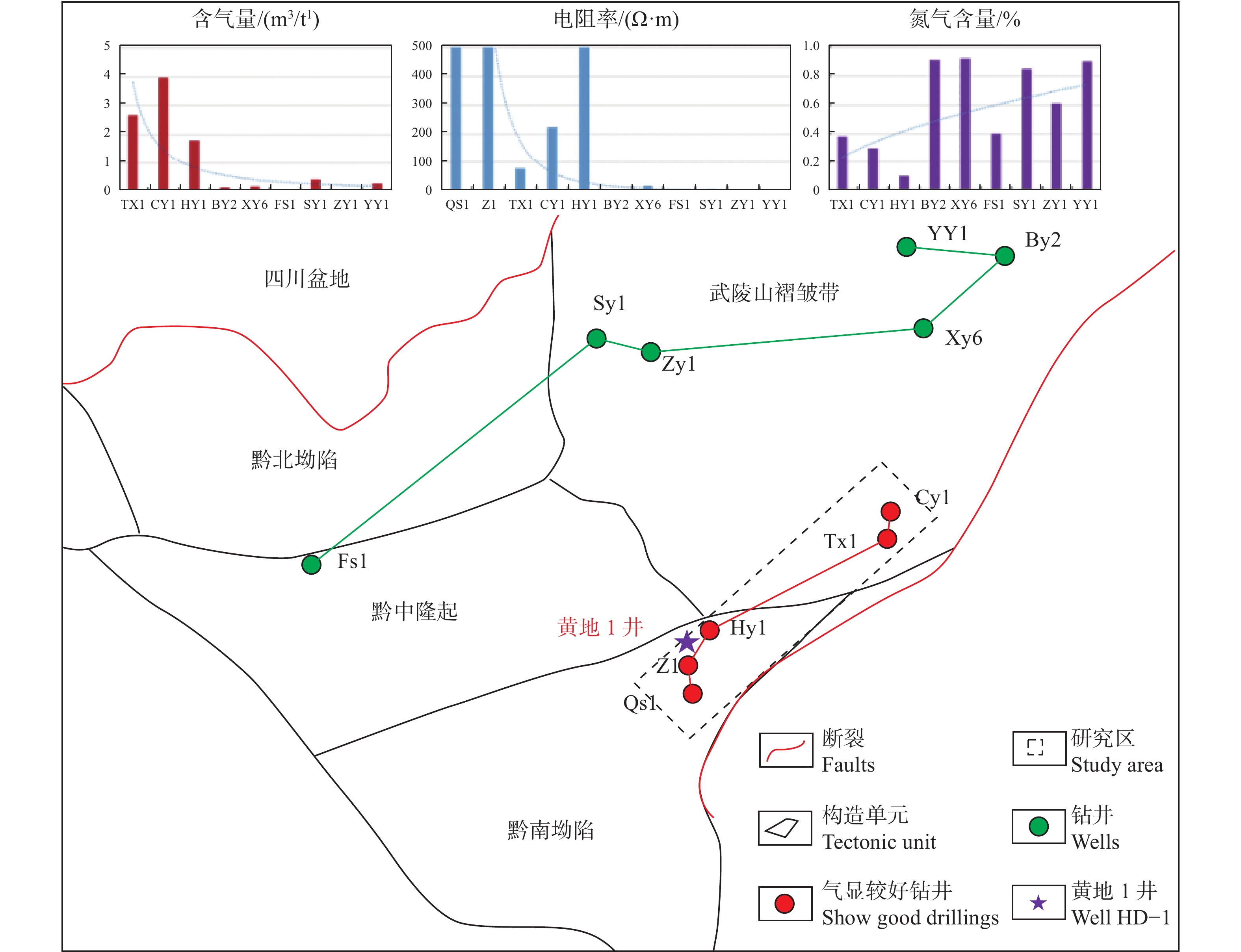
 下载:
下载:


